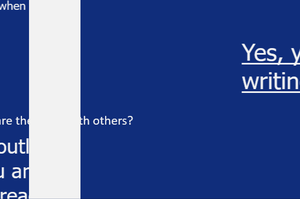 A supremely-talented improvisational musician can take to the floor and tell you that thoughtless, organic creativity is the purest form. This is not incorrect.
A supremely-talented improvisational musician can take to the floor and tell you that thoughtless, organic creativity is the purest form. This is not incorrect.
Plenty of great writers shoot from the hip. That is a capital skill. Stephen King didn't write hundreds of books by putting up his feet; he wrote them because he didn't stop writing. Improvised writing is pure.
Then again, purity may not be your objective, in music, or in writing. Perhaps you need to immediately put an idea in your reader's head?
Keeping that in mind, you need to outline all your writing projects...
Begin your writing outline with a verb for you and an adjective for the reader.
An outline begins with a verb. That verb will illicit a feeling in the reader. Without this clarity, your work will risk instability. A thoughtful verb cements a contract with the reader. The subsequent feeling they experience details what the reader can expect to feel, learn, or experience. While truly skilled writers can lace this into their work on instinct, it's likely taken years of practice and thousands of words to codify the natural tendency.
Even a small writing project can benefit from a small outline. Begin with a thesis statement: try one sentence.
The reader is excited to discover a NEED for outlines is universal, no matter the project's breadth or objective.
This is only a loose outline, but it includes the verb and the adjective each respective party will drive toward.
The piece's purpose is immediately clarified. Why is the writer bothering to write it? Why is it important to the audience? The more straightforward your outline, the more obvious this will be, and the less the reader's brain will need to chug to keep up.
I'll often add bullet points, sentence prompts, or reminders for myself beneath this one-sentence outline. I'll take care to not stray beyond its scope. The outline has already begun saving me time. Recall how often you're knee deep in a post, a script, or a story, and you have to decide if something belongs?
Now, if it doesn't fit within the outline's borders, you've already answered your own question.
This doesn't mean there isn't any mystery to tease out.
Extend your outline with a follow-through on the initial promise.
Consider this the next step in the reader's journey. Now that your first objective has been presented and its reason for being made clear by the initial outline-thesis.
It's the next step in your magic trick. Time to give yourself an obvious playing field: write another outline sentence.
The reader's earlier assumptions are upended, alarmed, when they SEARCH for new advice in the blog post.
You skim pieces of writing all the time. This is fine, but wouldn't it be nice if you knew your audience was truly reading each word you bother typing? Outlining your work reminds you when exactly to include a plot twist.
Countless blog posts are straight-line lists. Decades of movies shoulder predictable plots (if any plot at all). Centuries of aimless literature bore readers to death. Honor and delight your audience's persistence with expertly-timed surprises. The best way to do this is with a tiny outline identifying what you want the readership to feel and what their active mindset is at the moment of discovery.
If you're inviting them to skim (search) a blog post, modify the narrative. Show them what it's like for those who bother to show up.
Outlines save you time.
The reader feels respected, time well-spent, as they RETURN to their life's usual flow.
Again, you can include key ideas or bullet-lists to remind yourself what the reader needs to know as you close things out. Endings can be tricky. They're easier when you know what you want to leave your reader feeling.
Your audience will leave you. Know precisely what they ought to feel as they depart. Will they be prepared to return? Have you considered the taste in their mouth? Would they share the work with others?
A 10-15 minute outline has saved me hours of writing a blog post.
A 3 hour outline has saved me days of story writing.
A month-long outline has saved me years of drudge.
This practice scales with whatever you're producing.
If you have more ideas, include them in the comments section below, or contact me on social media. You can sign up for the Ghost Little email subscription via the link below, as well.

